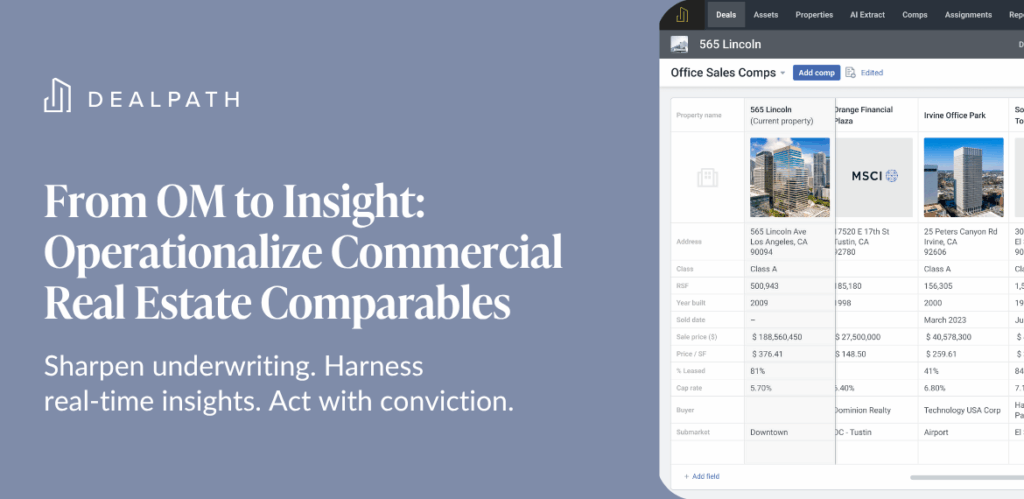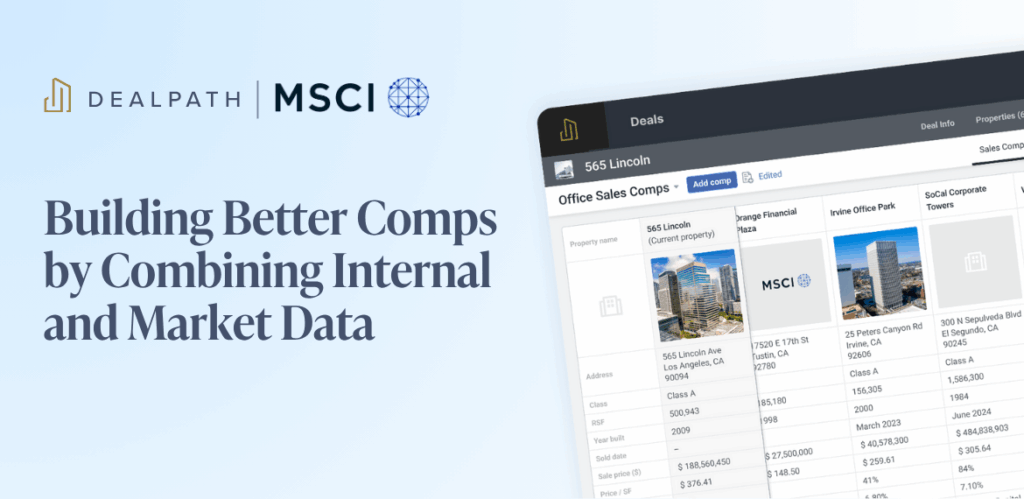Underwriting commercial real estate deals carefully–yet quickly–is vital in building a competitive advantage in a fast-paced market. To react to new opportunities with speed and precision, industry leaders rely on centralized, vetted data from one command center. The ability to instantly surface data or commercial real estate underwriting models based on various scenarios creates meaningful efficiencies for real estate pipeline management and underwriting workflows.
Strategically adopting data-driven technology empowers your firm to underwrite deals with greater speed, efficiency and precision. Read on to learn how streamlined, centralized access to data accelerates commercial real estate underwriting, helping your firm to outperform competitors.
Faster, More Accurate Underwriting Is Vital to Building a Competitive Advantage
No matter how precisely you can model cash flows in Argus, accessing that data–together with relevant comps–is another challenge entirely. Scouring your inbox and internal drives to surface documents and comps can add significant friction during the underwriting process, prolonging decisions. In the end, can you act on this information with confidence?
Deal management platforms like Dealpath simplify commercial real estate underwriting workflows across equity and debt origination deals with a globally accessible reportable deal database, putting data at your fingertips. Simplifying and automating data-driven workflows ensures that your team can collaborate in lockstep, conserving valuable time for deeper analyses.
With data highly accessible, teams are able to surface the best opportunities faster and, ultimately, close on deals before the competition.
1. Leverage Third-Party Commercial Real Estate Underwriting Data Sources
Your commercial real estate underwriting process is only as precise as the data it’s predicated on. While comps drive much of the commercial real estate underwriting process, your data may not always paint a complete picture. Teams can better surface risk and understand market trends by supplementing proprietary intelligence with third-party datasets.
Commercial real estate databases, such as Altus and CoStar, provide meaningful data teams can use to enhance their analyses. Relying on trusted third-party data providers enables your deal team to better identify trends and pinpoint profitable opportunities with more comprehensive market context.
2. Surface Historical Comps to Identify Trends and Underwrite Commercial Real Estate Deals Strategically
Teams that halt their workflows to surface comps from inboxes or spreadsheets ultimately slow pipeline momentum. In today’s fast-paced market, manually pulling data is not a scalable, efficient or reliable process. Beyond operational inefficiencies, relying on siloed data also creates the risk of preventable human error.
Deal management platforms like Dealpath centralize and standardize data, empowering investors to pull relevant comps instantly. A searchable, reportable deals database can empower your team to find comps in seconds. Beyond building confidence in data, deal management platforms also help investment teams to act with greater conviction.
3. Standardize Commercial Real Estate Comparable and Underwriting Data
Your team can’t effectively make comparisons when your proprietary data is stored in various formats. To make swift, precise apples to apples comparisons and optimize your workflows, you need standardized data.
As you source new opportunities, deal management platforms like Dealpath automatically standardize data to ensure consistency. Leveraging modern tools allows your team to start analyzing immediately–eliminating the tedious task of harmonizing datasets from your workflow.
4. Find Structured Ways to Track Models Based on Various Scenarios
From the pandemic’s immediate impact on real estate capital markets to ongoing fluctuations amidst global volatility, investors understand the importance of comparing various market scenarios now more than ever. Modeling return scenarios based on various market assumptions enables teams to better manage risk and make investments aligned with their strategies. Nonetheless, tracking multiple disjointed models can quickly become confusing.
Whether you’re in the midst of underwriting a commercial real estate deal or measuring performance against projections, accessing models as market conditions shift is imperative. Centralizing these models–together with other deal data and documentation–empowers your firm to react more nimbly and strategically based on its goals.
5. Strengthen Assumptions With Portfolio Data
Owned portfolio data can provide significant insight into how pipeline properties may perform in current market conditions. Rather than pivoting between various tools to view this data, your team can build efficiencies by leveraging strategic integrations among trusted software solution providers.
For example, Dealpath customers can integrate certain data points from ERP platforms like Yardi and MRI software through the open API. In the future, Dealpath clients will be able to surface even more market and portfolio data through partnerships with Cherre and NavigatorCRE to strengthen commercial real estate underwriting assumptions.
Optimizing Commercial Real Estate Underwriting
Harnessing the power of your data with powerful reporting and analytics is key to expediting the underwriting process, all while positioning your firm to scale pipeline and portfolio growth.
Download our white paper, 3 Strategies To Boost Deal Velocity And Grow Your Portfolio Of AUM, to learn how clear visibility enables your firm to accelerate at every stage in the pipeline process.
Download eBook



